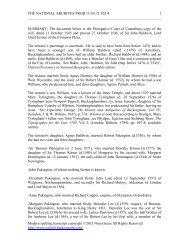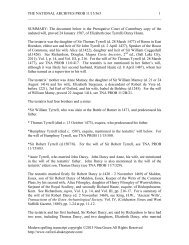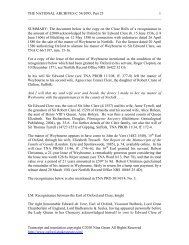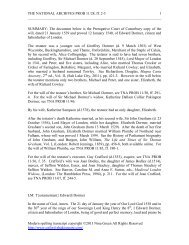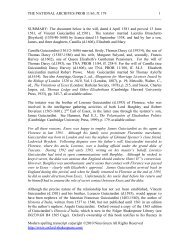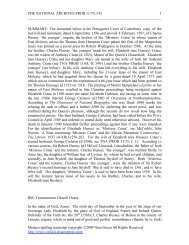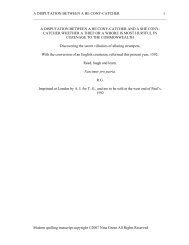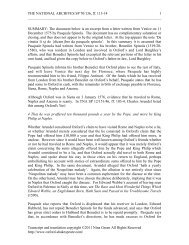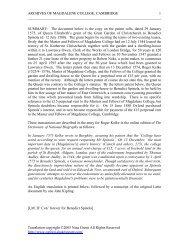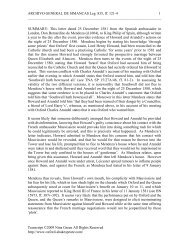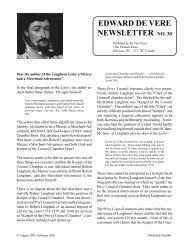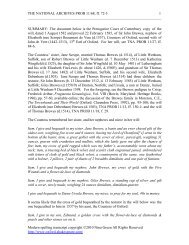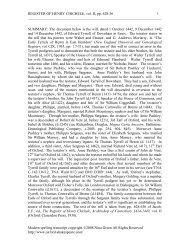Kathman refutation - The Oxford Authorship Site
Kathman refutation - The Oxford Authorship Site
Kathman refutation - The Oxford Authorship Site
You also want an ePaper? Increase the reach of your titles
YUMPU automatically turns print PDFs into web optimized ePapers that Google loves.
FALSE PARALLELS IN DAVID KATHMAN’S ‘DATING THE TEMPEST’ 22<br />
________________________________________________________________________<br />
by a sulphurous smell and a roaring noise. It causes men to jump overboard in<br />
desperation. Could anything be more different from the St. Elmo's fire described in<br />
Strachey?<br />
During all this time the heavens looked so black upon us that it was not possible the<br />
elevation of the Pole might be observed; nor a star by night nor sunbeam by day was to<br />
be seen. Only upon the Thursday night Sir George Somers, being upon the watch, had an<br />
apparition of a little, round light, like a faint star, trembling and streaming along with<br />
sparkling blaze, half the height upon the main mast and shooting sometimes from shroud<br />
to shroud, ‘tempting to settle, as it were, upon any of the four shrouds. And for three or<br />
four hours together, or rather more, half the night, it kept with us, running sometimes<br />
along the main yard to the very end and then returning; at which Sir George Somers<br />
called divers about him and showed them the same, who observed it with much wonder<br />
and carefulness. But upon a sudden, toward the morning watch, they lost the sight of it<br />
and knew not what way it made. (Wright, pp. 12-3)<br />
In Strachey’s description, St. Elmo's fire is a gentle thing compared to Ariel's hellish<br />
apparition of flame everywhere on the ship, and there is no accompanying roaring noise<br />
or sulphurous smell.<br />
This analysis is supported by a description of the physics underlying St. Elmo's fire.<br />
http://www.physics.northwestern.edu/classes/2001Fall/Phyx135-<br />
2/17/whatisstelmosfire.html<br />
What is St. Elmo's Fire?<br />
St. Elmo's fire is a plasma (i.e. a hot, ionized gas) that forms around the tips of raised,<br />
pointed conductors during thunderstorms. It is known as a corona discharge or point<br />
discharge to physicists. <strong>The</strong> few people that have had the privilege of viewing an actual<br />
St. Elmo's fire have given various descriptions. It has been seen with different physical<br />
characteristics depending on the conditions of the viewing. It could be blue to bluishwhite,<br />
silent to emitting a hissing sound, and ghostly to solid.<br />
What are the conditions for its occurrence?<br />
St. Elmo's fire occurs during thunderstorms - generally after the most severe part of the<br />
storm has passed - when the air reaches a very high voltage. <strong>The</strong>se conditions are<br />
necessary to accumulate a charge large enough to create the phenomenon. It is always<br />
found attached to a grounded conductor with a sharp point; the most common are masts<br />
of sailing ships, church steeples, airplane wings or propellers, or even horns of cattle.<br />
This description of the physics underlying St. Elmo’s fire corresponds closely to the St.<br />
Elmo’s fire described in the Strachey letter, but is very different from the terrifying<br />
phenomenon Ariel creates in <strong>The</strong> Tempest, with its lightening-like appearance and 'cracks<br />
of sulphurous roaring'. It is particularly noteworthy that in <strong>The</strong> Tempest Ariel’s 'fire'<br />
© 2005 Nina Green All Rights Reserved<br />
http://www.oxford-shakespeare.com/



